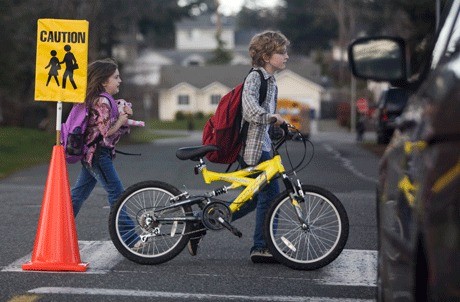A $339,925 grant from the Washington State Department of Transportation will cover new enhanced street crossings to improve school children’s safety during their commutes to and from school.
City Engineer Eric Johnston said the grant encompasses the “three E’s” of traffic safety: engineering, education and enforcement.
The grant will fund eight state-approved crosswalks in Oak Harbor, said Johnson.
Bruce Worley, school district executive director of operations, is part of the Safe Routes to Schools Committee, a group comprised of school district coordinators, who chose the eight locations based on proximity to an existing designated walking route, school access and traffic volume.
The group studied student transportation to and from area schools and found that, on average, about 40 percent of students are driven to school by a family member; 35 percent ride the bus; 14 percent walk; 4 percent carpool; 4 percent bike; and about 2 percent use public transit or other forms of transportation.
Whitney Webber, Island County Public Health’s chronic disease prevention program specialist, and City Project Engineer Arnie Peterschmidt wrote the majority of the grant.
“She was a big, big help on this project,” Worley said of Webber’s involvement.
Island County Public Health and School District officials hope the Safe Routes to Schools Program will encourage more kids to walk and bike to school.
In Worley’s eyes, the increased visibility, signs and flashing lights will improve students’ safety as they travel to and from school.
“They’re really efficient at stopping traffic,” he said of the existing enhanced crossing on Heller Street between Oak Harbor High School and Hillcrest Elementary.
The “safe crossings” aren’t just paint on asphalt, Johnston said. The visibility around each location will be improved with overhead lighting, electronic signs and a flashing crosswalk.
“It would be nice if everybody stopped at a painted crosswalk, but they don’t,” Johnston he said of motorists.
The grant is divvied up among three groups: the city, school district and police department, based on the “three E’s” of traffic safety, and their costs.
The most expensive piece to the project will be handled by the city, which received $311,925 for the engineering and construction of sidewalks, installation of flashing crosswalks and overhead lighting.
The Oak Harbor Police Department will get $4,000 for laser speed detection equipment to help enforce the speed limit near the crossings.
“The most effective way to get compliance in the school zone is enforcement,” Johnston said.
The school district will use the remaining $24,000 for education and encouragement within the schools, Worley said. Island County Public Health will also help with the education factor.
Washington’s Safe Routes to Schools program began in 2005 and provides assistance and resources to cities, counties, schools, school districts and state agencies to improve pedestrian access within the community to encourage students to walk or bike to school.
Last year the Safe Routes to Schools Program received 112 grant requests from 86 agencies and organizations totaling approximately $47 million. Only 39 projects were chosen to receive the available $10 million in grants.



